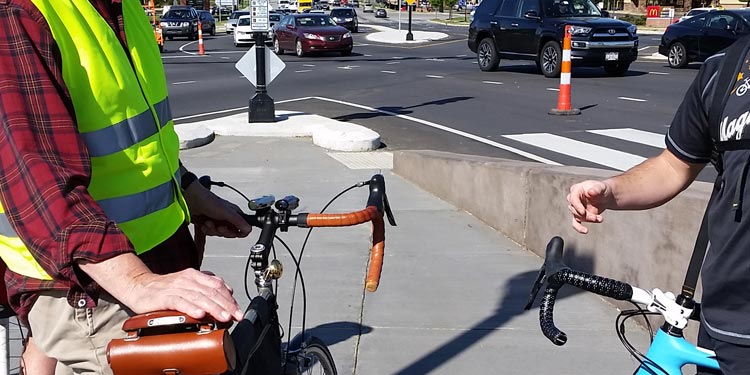In May, people around the United States will celebrate Bike to Work Month by leaving the car at home and cycling to work. It’s often the fastest way across town, and it’s a great way to get some exercise, reduce our carbon footprint and remember that roads are not just for driving.
From behind the steering wheel, it is tempting to think that motorists own the road, that cyclists are interlopers on our God-given asphalt. That’s why most drivers would be surprised to learn that it was cyclists, not motorists, who first pushed for high-quality, dust-free roads back in the late-19th-century.
Before motoring came along, roads and streets were used for transport, of course, but they were also public spaces—open for commerce, meetings, and yes, dancing in the streets. Some cities recreate that space by periodically banning cars. In Bogotá, Colombia, for example, during ciclovías –or “open streets” events –highways are closed to motorized traffic, and people take over, on skateboards, on roller skates, on foot and on bicycles. Space normally dedicated to motors alone becomes a venue for pop-up cafes, leisurely chats, architectural tours and more.
Reclaiming the street from cars—if only for a day—frees us to imagine a world that is not wholly shaped by the automobile. Indeed, the reign of the auto is not inevitable, and it is likely not permanent. This kind of thinking may be difficult for anyone born in the U.S. after, say, 1940. But it’s helpful to remember that previous generations felt the same way about their dominant modes of transport. If you asked an 18th century American what form of transportation would prevail, he or she would have answered “canals.” (The moribund C&O Canal, a notorious boondoggle, is testimony to how quickly that reality changed.) In the 19th century, and well into the 20th, the answer would have been “trains.”
Then, as now, few people could imagine what was (literally) coming down the pike. The dominant mode of transport captures our imagination and resources, sometimes blinding us to better alternatives.
So, what are those alternatives—and what will the future of transportation look like?
It probably won’t look like the car-centric present. As we face the existential challenge of climate change—not to mention the daily struggles of traffic jams and parking—some believe we have reached the age of Peak Car. Millennials, who are too busy peering at their smartphones to drive safely, anyway, are increasingly disenchanted with auto culture.
And change is in the air. That motor-car use ought to be restrained is becoming less of a minority position as the social, environmental, health and economic benefits of the “liveable city” are better understood. Cities that put quality of life for all before amenities for motorists alone are finding that one of the first steps towards civic “attractiveness” is to rip out much of the ugly infrastructure that motorists are deemed to require. Some of this motor-centric infrastructure – roundabouts, crash barriers, sweeping corners with long sight-lines – encourages motorists to travel faster, making urban areas sterile, unpleasant, and dangerous to those on foot or bike.
The future of transportation could hinge on some unforeseen technological game-changer. Or it might feature an idea that’s already in development— driverless cars, for example. While they might be good for those distracted millennials, driverless cars are fundamentally a dystopian vision of the future; a doubling-down on the automotive infrastructure that wreaks havoc on our climate, our cities, and our health. Imagine if the affluent purchase driverless cars for each member of their family—whole fleets of cars robotically shuttling each kid off to school or soccer practice. And you think traffic is bad now!
Alternatively—if we are lucky—the future of urban transportation will look something like the past. Yes, it will probably include cars, for the foreseeable future—though those cars will be much more efficient and less polluting. It will certainly include ubiquitous public transit: light rail, bus rapid transit and streetcars. And, increasingly, cars will share the road with cyclists, pedestrians and many forms of vibrant civic life.
Bicycles are especially well-suited to the realities of a future in which two-thirds of the world’s people will live in cities by 2050, and most journeys are less than three miles. Our bike-centric city could have some high-tech elements, as well, such as “bike lifts,” similar to ski lifts, that help cyclists up steep hills. The tension between motorists and cyclists would abate, Netherlands-style, as motorists realize that more bikes mean fewer cars—and less congestion.
If this vision sounds too good to be true, consider this: elements of it are already a reality in cities as diverse as Amsterdam, where half of all journeys are made by bike, and Curitiba, Brazil, a city whose efficient bus system has inspired copycats the world over.
The future of transit—the future of anything— remains inscrutable to us mortals. Still, during bike-to-work month, I will zip through town on my bicycle—and allow myself to dream.
Carlton Reid is author of Roads Were Not Built for Cars, published by Island Press. For nearly three decades, Reid has written about cycling, transport, and adventure travel. In this new book, Reid reveals the pivotal – and largely unrecognized – role that bicyclists played in the development of modern roadways, and encourages us to celebrate those links once again.






